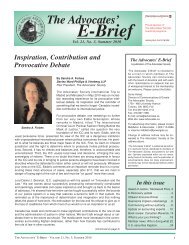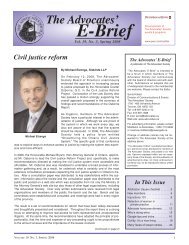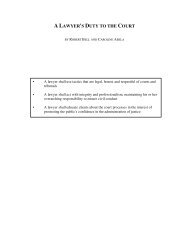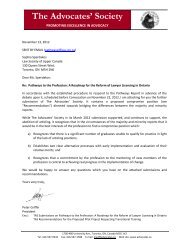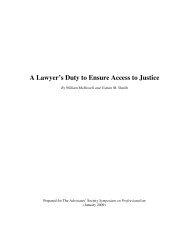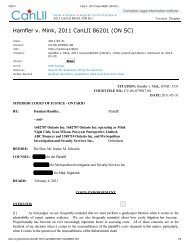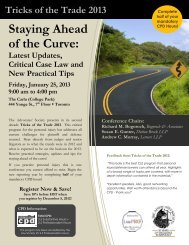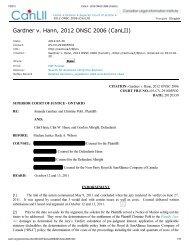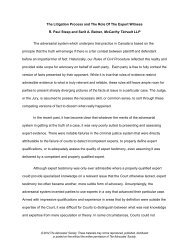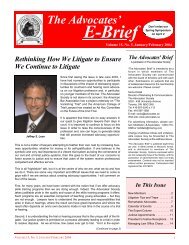E-Brief Sept - Oct - The Advocates' Society
E-Brief Sept - Oct - The Advocates' Society
E-Brief Sept - Oct - The Advocates' Society
- No tags were found...
You also want an ePaper? Increase the reach of your titles
YUMPU automatically turns print PDFs into web optimized ePapers that Google loves.
(Continued from page 9)disposition of the matter. Only theDistrict Court has the ability to modify aProtective Order that it has granted and,so, the court automatically has jurisdictionover the matter; there is no need tofind an additional independent basis forjurisdiction (Vitamins Antitrust Litigation,supra at para. 3). Additionally, there is a"... growing consensus among thecourts of appeal that intervention tochallenge confidential orders may takeplace long after a case has been terminated"(EEOC, supra at 1046). <strong>The</strong>rationale is that as no new claims arebeing adjudicated by the court, there isno prejudice (in terms of delay) to theoriginal parties to the action.Supreme Court of Canada Counseland Agency ServicesNow in its 24 th yearAvailable by e-mailSame day service<strong>The</strong> Gowling Lafleur Henderson LLP Supreme Court of Canada Serviceincludes a periodic summary, an Annual Report on all applications for leave toappeal, and related services.Supreme Court of Canada Group:Brian A. Crane, Q.C.Henry S. Brown, Q.C.Martin W. Mason<strong>The</strong> Power of Original ThoughtGraham RaganEduard J.Van Bemmel,Legal Assistant<strong>The</strong> third criterion is the only one that2600 – 160 Elgin Street Ottawa, ON K1P 1C3 Tel: (613) 233-1781has substance when using permissiveMontréal Ottawa Toronto Hamilton Waterloo Region Calgary Vancouver Moscowintervention to challenge a Protectivegowlings.comOrder. Nevertheless, as with the othercriteria, the moving party is granted considerableflexibility and there is movementtowards decreasing the difficulty of meeting this criterion as well. Multiple courts have held that simply raising a question commonto both the foreign suit and the one in the U.S. jurisdiction will satisfy the requirement of commonality (United Nuclear Corp. v.Cranford Insurance Co., 905 F.2d 1424 at 1427 (10th Cir.1990)). In both Re Linerboard and Re Vitamins, where the Canadianactions were almost identical to the American actions, both courts held that the commonality requirement was satisfied. Further,there is at least one circuit court that has adopted a very liberal interpretation of this requirement, such that simply challenging eitherthe scope or the need for the Protective Order is sufficient to meet the commonalityrequirement (Pansy v. Borough of Stroudsburg, 23 F. 3d 772 at 777-778 (3rdCir.1994)). While this interpretation has been mentioned in a number of other cases,there are few that actually apply it -- I believe likely because if the proceeds of theintervention are to be useful in the foreign action, there needs to be commonalitybetween the two actions. Consequently, as all of the criteria for permissive interventionare easily satisfied, the entire inquiry becomes an exercise of discretion.<strong>The</strong> Exercise of DiscretionEven where the test for permissive intervention is met (and I suggest that is quiteeasily done), the court is not mandated to grant intervention. <strong>The</strong> court has "considerablediscretion" and the guiding principle is "whether the intervention will undulydelay or prejudice the adjudication of the rights of the original parties" (EEOC, supraat 1048). In exercising this discretion, one court has suggested that they will weighefficiency concerns, reliance interests on the continued integrity of the protectiveorder and the public interest in open court records. Efficiency concerns were the rootof the decision in Re Vitamins, where the judge stayed his decision pending the outcomeof class certification motions in Canada, reasoning that it was more efficient todeal with intervention once all of the Canadian parties were known. Finally, in manycases, the courts have allowed modification where access to the protected materialwould negate the need for that party to engage in duplicative discovery (Wilk v.American Medical Association, 635 F.2d 1295 at 1300 (7th Cir.1980)).ConclusionPermissive intervention under Rule 24(b) potentially allows Ontario litigants access tothe proceeds of the broad discovery rights of U.S. courts without a letter of request.Although there are few decisions with respect to Canadian litigants, the Americandecisions suggest that the standard for permissive intervention is easy to meet, andmuch will depend on the court's exercise of discretion. In substantially similar proceedingsin Canada and the U.S., where the potential danger of duplicative discoveryis great, permissive intervention is likely a better option to obtain discovery evidencethan a letter of request.<strong>The</strong> Sir William CampbellFoundation's VolunteerCommittee will be takingorders for their holidaygreeting cards and famouspoinsettias in late<strong>Sept</strong>ember. Please watch fordetails on their website at:www.campbellhousemuseum.ca.Thank you for supportingCampbell House10VOLUME 18, NO. 1, SUMMER 2006



